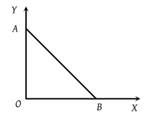If a charged spherical conductor of radius 10 cm has potential V at a point distant 5 cm from its centre, then the potential at a point distant 15 cm from the centre will be -
1.
2.
3.
4. 3 V
The ratio of momenta of an electron and an -particle which are accelerated from rest by a potential difference of 100 volt is
1. 1
2.
3.
4.
| 1. | \(V \neq 0 \text { and } \vec{E} \neq 0\) |
| 2. | \(V \neq 0 \text { and } \vec{E}=0\) |
| 3. | \(V=0 \text { and } \vec{E}=0\) |
| 4. | \(V=0 \text { and } \vec{E} \neq 0\) |
A proton is about 1840 times heavier than an electron. When it is accelerated by a potential difference of 1 kV, its kinetic energy will be -
1. 1840 keV
2. 1/1840 keV
3. 1 keV
4. 920 keV
As per this diagram a point charge +q is placed at the origin O. Work done in taking another point charge –Q from the point A [co-ordinates (0, a)] to another point B [co-ordinates (a, 0)] along the straight path AB is

1. Zero
2.
3.
4.
The capacity of a condenser is 4 × 10–6 farad and its potential is 100 volts. The energy released on discharging it fully will be -
1. 0.02 Joule
2. 0.04 Joule
3. 0.025 Joule
4. 0.05 Joule
The energy stored in a condenser of capacity C which has been raised to a potential V is given by -
1.
2.
3. CV
4.
Eight drops of mercury of equal radii possessing equal charges combine to form a big drop. Then the capacitance of bigger drop compared to each individual small drop is
1. 8 times
2. 4 times
3. 2 times
4. 32 times
The capacity of a parallel plate condenser is C. It's capacity when the separation between the plates is halved will be?
1. 4 C
2. 2 C
3.
4.
If the dielectric constant and dielectric strength be denoted by \(k\) and \(x\) respectively, then a material suitable for use as a dielectric in a capacitor must have:
1. high \(k\) and high \(x\).
2. high \(k\) and low \(x\).
3. low \(k\) and low \(x\).
4. low \(k\) and high \(x\).






